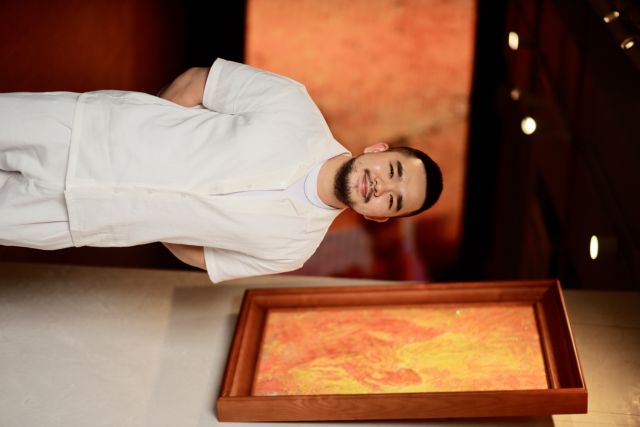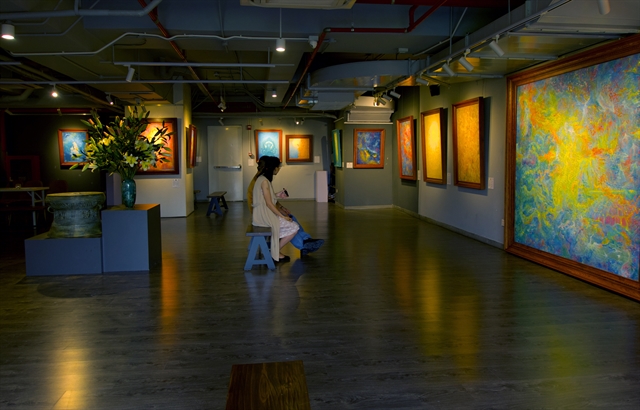 Life & Style
Life & Style

Nguyễn Thanh Vũ, 29, is a painter who quit a career in architecture to pursue art. His paintings are mostly influenced by traditional culture. They have gone on show at many exhibitions around the country. Vũ wants to exhibit his works abroad to both show off his own art and present Vietnamese culture to a wider audience. Việt Nam News reporter Thu Ngân speaks with Vũ about his love for art and plans for the future.
 |
| Nguyễn Thanh Vũ, who wants to take Vietnamese art to the world. Photo courtesy of the artist |
Could you tell us a bit about yourself?
I was born in the central province of Quảng Ngãi, was originally an architect, have a deep passion for drawing, and I'm currently better known as an artist.
I believe that painting is also culture, reflecting the true nature of the times. Pursuing post-impressionism, I focus on emotions and the inner power of colours and artworks and I'm often known for my paintings.
I hope my paintings can convey positive, vital and peaceful energies to beholders.
Why did you decide to change to painting after working as an architect?
After graduating with a major in architecture, I worked as an architect for a while but felt architecture wasn't suitable for the office environment, and so decided to change direction.
I remember it was during the COVID-19 quarantine period. I chose to paint partly to relieve stress and partly because it was the only job I could do at that time, posting pictures on social networking platforms. I received a lot of responses from people, and so I kept on painting, and am painting until now.
It is said that an architect is a person with one leg as an engineer and one as an artist. They can't fly too far, they believe in reality and possibility. But that's not the case with artists; painting for me is not just about playing with colours, but also a way to tell stories and best reflect one's ego.
From a desire to go beyond the normal limits of an architect, I chose a life full of dreams and freedom, and painting helped me do that.
What inspired you to focus on post-impressionism and what are the main materials used in your creations?
It is no exaggeration to say that a painting is a copy of the author's inner mind or spirit. Anyone who paints can indirectly express their inner feelings, or more simply, their immediate mood at the time of painting. I just draw and paint as freely as possible, more precisely, paint in a way that is my own without worrying about the opinions of others.
Post-impressionism allows me to realistically portray emotional content, and so I have focused on this style.
I had the opportunity to come into contact with oil paints when I was a student, and felt emotional about a material that is both smooth and strong, durable over time. So I chose this material to practise painting.
 |
| A painting by Nguyễn Thanh Vũ. Photo courtesy of the artist |
How have your experiences working as an architect helped you in your painting career?
An interesting question. I am very passionate about architecture, and architecture is very much related to other fields, including culture and history. After that, I fell in love with this field and chose this topic to paint throughout my painting career.
The architectural work environment allows me the opportunity to access many tools to help manage work, come up with drawing ideas, expand to communicate effectively with customers. Architecture also helps me be rational in solving problems I think I wouldn't if I were purely an artist.
In addition, as an architect, I know which paintings will suit which spaces, which is very helpful in choosing the topic as well as the size of a painting when creating one.
Your passion for Vietnamese cultural themes is evident. Can we expect your future creations to continue exploring this theme?
Culture and history will be my topics throughout my artistic journey. I've been planning for the next collection, which will introduce Vietnamese songs, that have been around since before I was born. I want to transform those songs into paintings so that people can get a different feeling about putting music into paintings and not just poetry into music. I want the timbre, pitch, rhythm, and lyrics of the song to be expressed in the form of artwork, a painting.
This is also an opportunity for me to access the arts of the nation and introduce them to everyone, especially young people, so that they can understand about their own origins and heritage.
 |
| Vũ organises and takes part in exhibitions to display his artworks. Photo courtesy of the artist |
What do you think about the current interest in paintings and art collection?
From the perspective of an artist, I see rapid development in the Vietnamese painting market, with more and more exhibitions taking place every year and the public responding increasingly, which proves that the masses have transformed and become more interested in the country's art though the economy is facing challenges.
The Vietnamese painting market is considered a child that is gradually growing up.
Collectors can invest by buying works by famous artists. With new collectors entering the market, they can choose to buy sketches, one-of-a-kind prints or small-scale paintings by young and not famous artists, paintings are not receiving attention, and so their value is not high.
But over time these collectibles will likely increase in value. The problem is only a matter of perception, evaluation and, of course, knowledge and understanding.
The history of world painting has seen many events and investments in painting. Vietnamese are behind in this field, but it is good to learn from the lessons of the past. VNS




